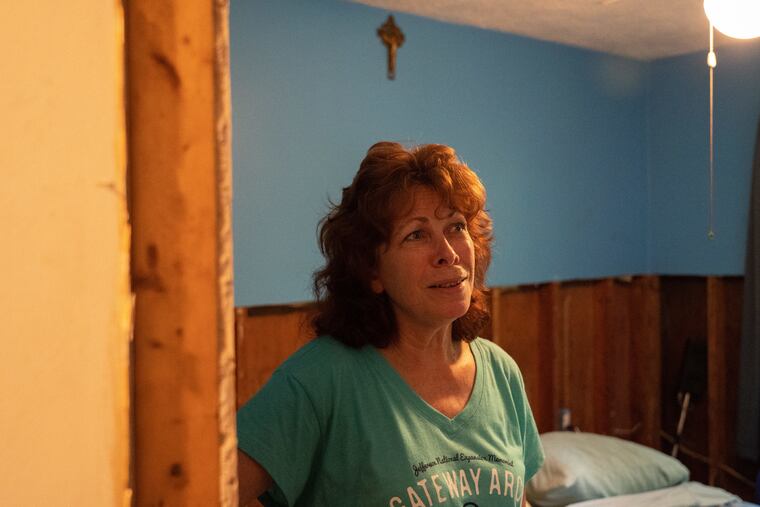In two small South Jersey towns, 63 homeowners will leave their flooded homes — if the state’s offer makes financial sense
Sixty-three South Jersey homeowners have been accepted into the Blue Acres Buyout Program, one of the largest community buyouts the program has encountered since Hurricane Sandy.

As about 100 South Jersey residents gathered inside a Southampton Township school gymnasium to learn the potential fate of their homes, ravaged by a June flood, an intense rainfall was thrumming from above, muffling the presenter’s words and unsettling residents’ stomachs.
To homeowners in the small towns of Burlington County, that relentless pitter-patter brought flashbacks of six-foot floodwaters bursting through their doors.
“Excuse me, I’ve got to go home and sandbag,” Denise Lees said under her breath sarcastically.
Lees’ home on Lenape Trail was completely flooded in June after the Rancocas Creek overflowed for the third time in 15 years. Four months later, Denise, her husband, Bill, and their 33-year-old son are still living without floors and drywall. They sleep on air mattresses and cook dinners on a hot plate and grill.
But there’s been a shift in Lees’ luck. Her home has been accepted into the Blue Acres Buyout Program, an initiative by New Jersey’s Department of Environmental Protection that purchases clusters of storm-damaged homes from residents in high-risk flooding areas. She finally sees a way out.
Lees is one of 53 Southampton and 10 Pemberton Township homeowners accepted by Blue Acres, according to a DEP spokesperson. The June flooding has prompted one of the largest community buyouts that the program has had since Hurricane Sandy in 2012.
The buyout process typically takes two to three years, officials said, but in an effort to help homeowners and save the government money, Blue Acres officials hope to close on properties as early as possible next year.
“We are helping whoever is asking for our help. And these people came together as a community. You can’t say no to that. It’s the perfect time to see what we can do,” said Fawn McGee, director of the program.
Blue Acres looks to buy clusters of homes, usually not single properties, to maximize space. So as soon as resident Orly Buday heard about it in August, she started organizing, going door-to-door, leaving a Blue Acres application, a personalized letter, and her cell-phone number. She knew that if she and her neighbors were going to be accepted into the program, they had to band together. Within two weeks, residents had submitted their applications, and now, accepted residents are awaiting offers.
Buday’s 3,000-square-foot home has been flooded three times since her family bought it in 2004. She, her husband, Larry Foster, and their two teenage children have been renting a home in Shamong Township since June’s destruction. They pay upward of $3,000 a month on their mortgage, water, and electricity for a home they can’t live in.
“I really think it’s pointless to put money into a house to have it knocked down,” Buday said.
Since Blue Acres was started in 1995, it has made offers on 967 properties, closed on 700, and demolished 640 statewide. Across South Jersey, it has also made purchases in Downe and Lawrence Townships in Cumberland County and Pleasantville in Atlantic County, as well as North Jersey counties hit hard by floods.
The money that would be used to purchase these Burlington County homes is left over from a $300 million commitment to buying flood-prone homes that Gov. Chris Christie made in 2013. Because the funds were designated in Sandy’s aftermath, the Southampton homes will be priced at their pre-Sandy, October 2012 values. If the home was purchased after that, it will be priced at current market value. The program also offers mortgage-debt forgiveness.
Home appraisals for the Burlington County residents will begin in November, and then title confirmation and environmental inspections will take place. After that, offers will be made and contracts drafted, and if all is settled, the sales will close and the homes will be demolished. The land will become public property and revert to its natural state — typically a grassy wetland — to mitigate future floods.
But many residents are nervous about the appraisals — if they aren’t offered enough money, they may have to turn down the offer and start rebuilding. Some described it as being stuck in limbo.
Denise Lees has received about $100,000 in insurance money to repair her home, but she’s struggled to find contractors to finish the work. She purchased a new washer and dryer and a heater, and had insulation put into the home’s main walls in preparation for winter. But she doesn’t want to put more money and time into repairs if she is going to sell her home.
“It’s kind of like being at a fork in the road — standing and waiting and not knowing which way to go,” she said.
That’s why McGee wants to speed up the purchasing process — to prevent homes rebuilt with federal flood insurance money from eventually being bought by the government and torn down.
“Instead of paying for it once, as taxpayers, we are paying for every structure twice,” McGee said. "It’s got to stop.”